10 Fish for a Small Aquarium
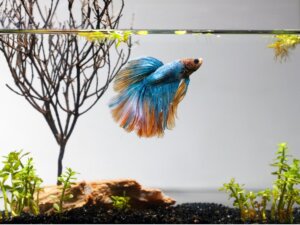

Written and verified by the biologist Samuel Sanchez
Want to get started in the world of aquarium keeping but don’t know where to start? Maybe you’re looking for a large tank with a high volume, or on the contrary, you may have little space and want to start practicing with something more modest. If you’re considering the latter option, here are 10 fish for a small aquarium.
First of all, we need to define the term “small”. We’re going to work with volumes of 10 to 40 liters (2.2 to 8.8 gallons) as less would imply a lot of suffering for virtually any species on this list. In addition, you should keep in mind that in small tanks you need to measure the water parameters more often, as they fluctuate easily. So, without further ado, let’s get to it.
10 fish for a small aquarium
1. Betta fish (Betta splendens)
The betta is the king of freshwater fish. Originally from Southeast Asia, this fish is perfectly adapted to small aquariums. Moreover, because it has a special suprabranchial labyrinth organ, it’s able to take oxygen directly from the environment. Therefore, it doesn’t need the water to be well-oxygenated.
However, the fact that betta fish are hardy doesn’t mean that they can be kept in a glass of water or in a glass bowl. Under these conditions, it will suffer from fungal and bacterial infections and will eventually die. We recommend that, no matter how modest the tank, you get a heater and a basic filtering system for your specimen.
- Minimum aquarium size: 10 liters (2.2 gallons)
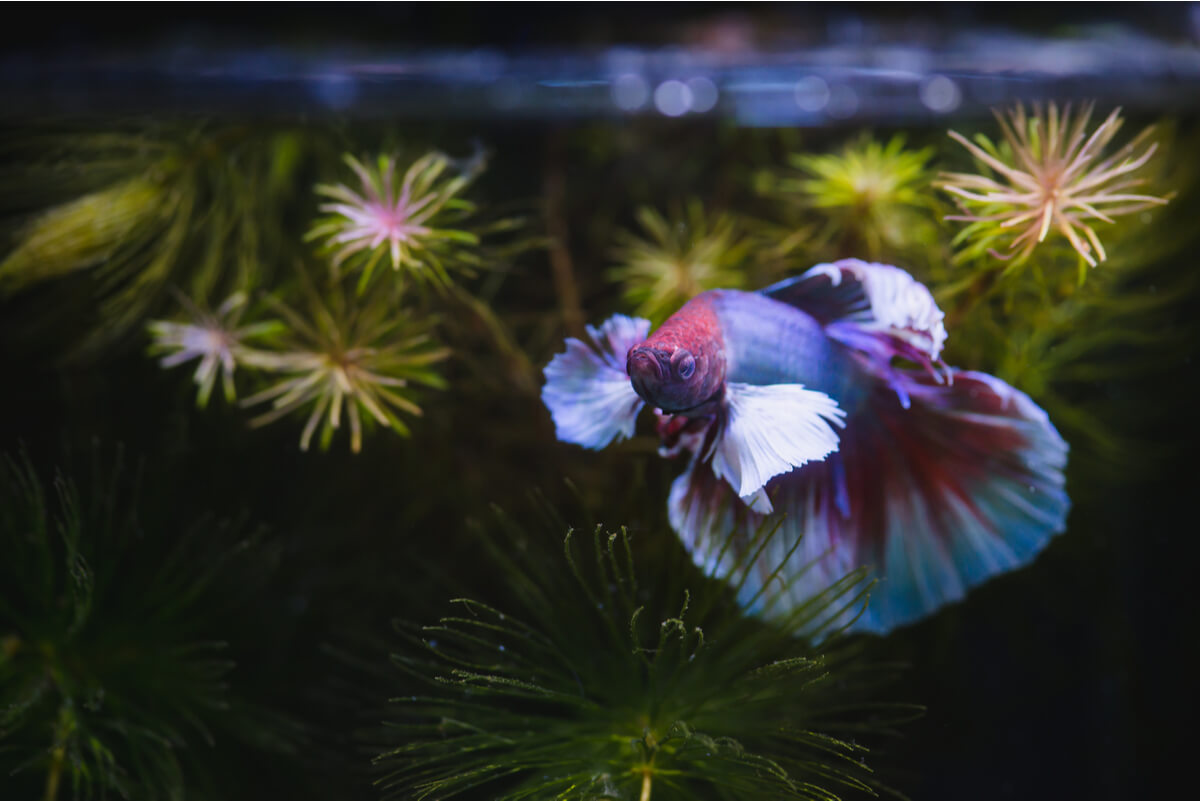
2. Galaxy rasbora (Danio margaritatus)
This fish, belonging to the same genus as the zebrafish (Danio rerio) was discovered in mid-2006 in Asia. It’s one of the most recently introduced species for aquarium enthusiasts, but has won people over with its reddish fins and yellowish spots all over its body.
This fish is very small (a maximum of 1.5 centimeters, just over half an inch), but requires more space than a betta as far as tank volume is concerned. As it’s a schooling species, at least 6 specimens must be acquired so that they don’t become depressed and die over time.
- Minimum aquarium size: 20-30 liters (4.4 to 6.6 gallons) minimum for 6 specimens.
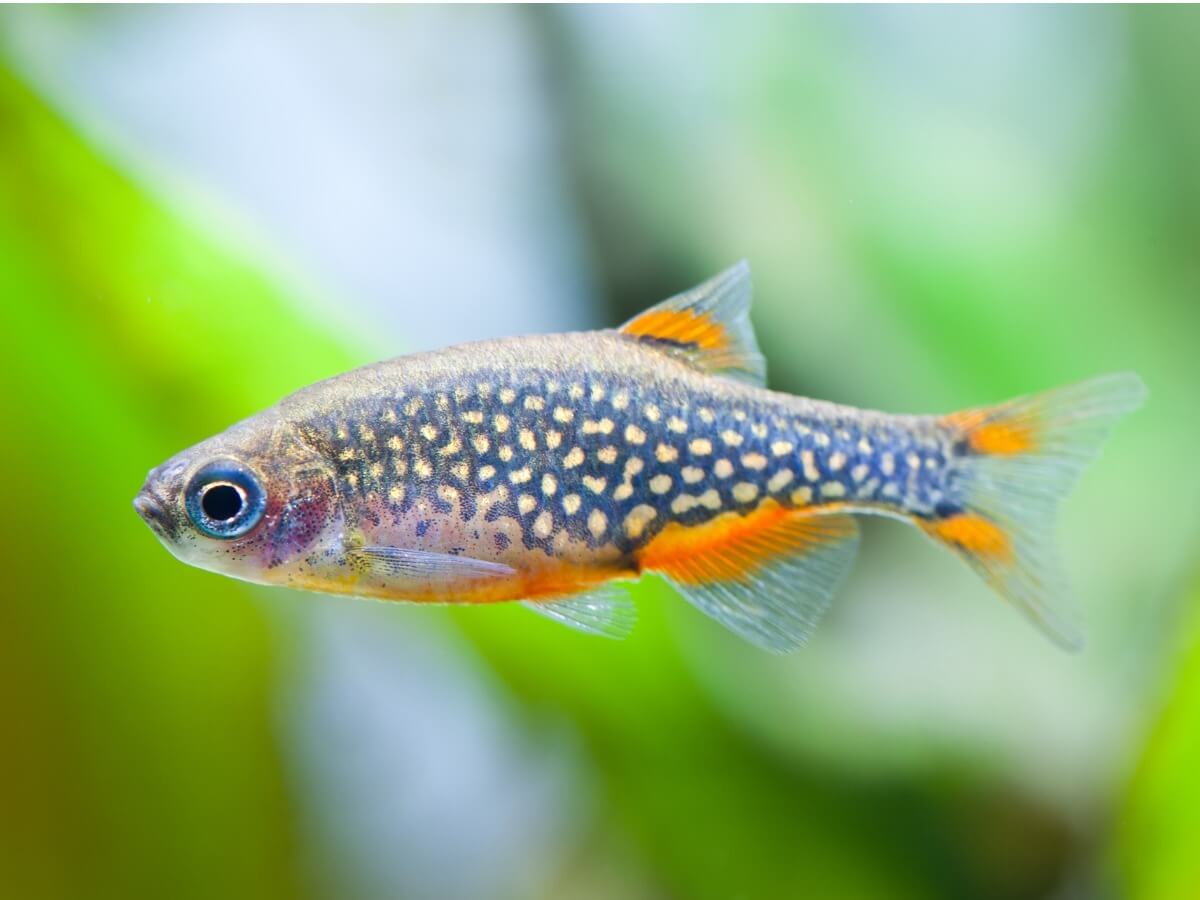
3. Mosquitofish (Gambusia affinis)
The mosquitofish is quite similar to the guppy as far as body plan is concerned, but does not have such striking colors. They’re ideal fish for small aquariums, as females do not exceed 7 centimeters (nearly 2 inches) in length and males are no longer than 4 centimeters (less than 2 inches). Their small size and curious habits make them a very interesting option.
Unfortunately, this species is listed as one of the 100 most harmful invasive species in the world. It has been introduced in many ecosystems to kill mosquito larvae and has settled too well, displacing the native fauna in many regions. In addition, they’re gregarious animals, so it’s recommended that you increase the volume of the tank to hold more specimens.
- Minimum aquarium size: about 20 liters (4.4 gallons) for a trio would be fine. However, a 60-liter tank (13.2 gallons) is recommended to hold about 25 specimens together.
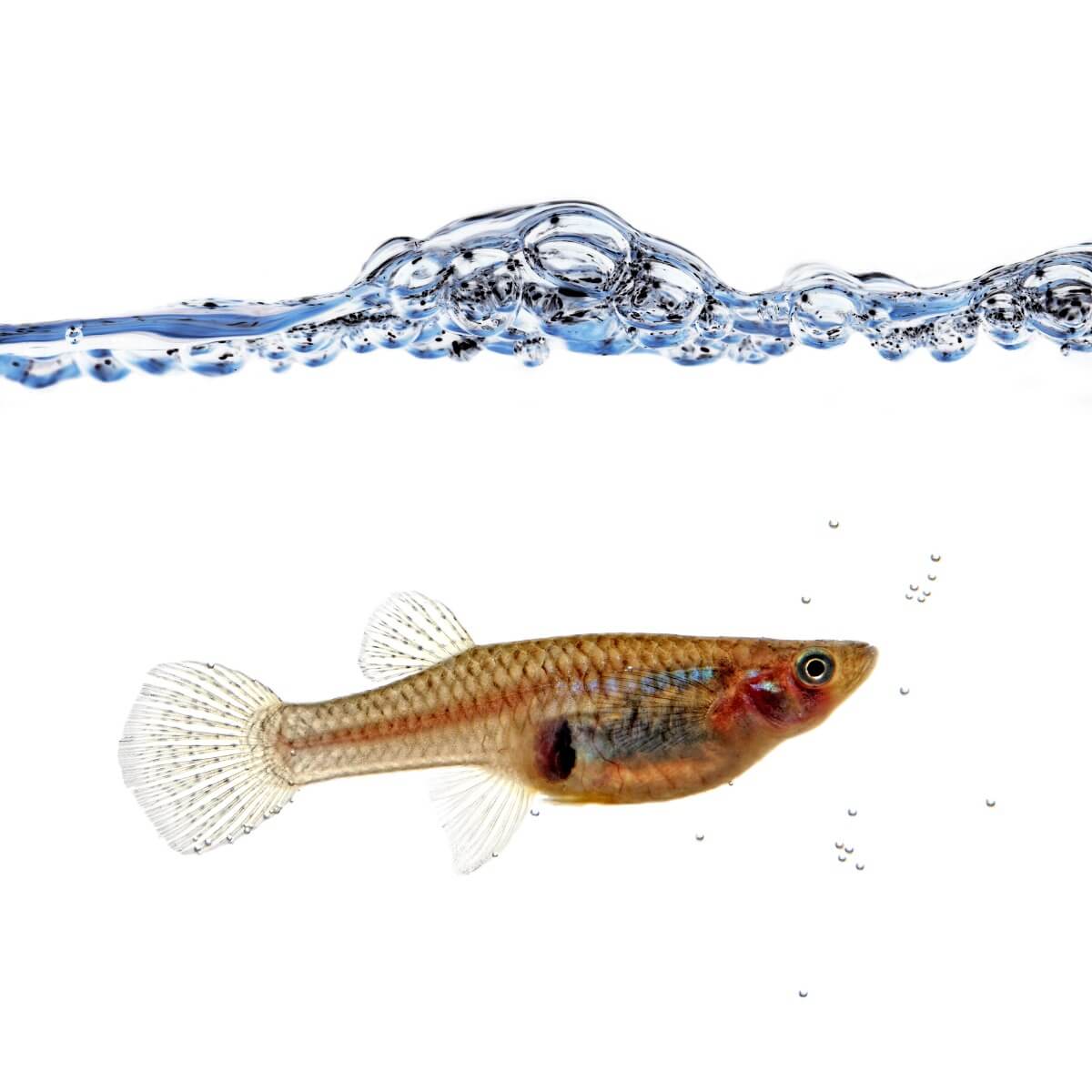
4. Guppy fish (Poecilia reticulata)
What can we say about this fascinating species? Guppies are ideal fish for a small aquarium, as males range in length from about 2 centimeters (just under an inch) and females almost never exceed 5 centimeters (2 inches). They’re even smaller than Gambusia, and they also show fascinating colors on their tails. Undoubtedly, one of the best options for people new to this hobby.
- Minimum aquarium size: 40 liters (8.8 gallons) for a breeding group. They’re very prolific, so consider moving them to a larger tank at a later date.
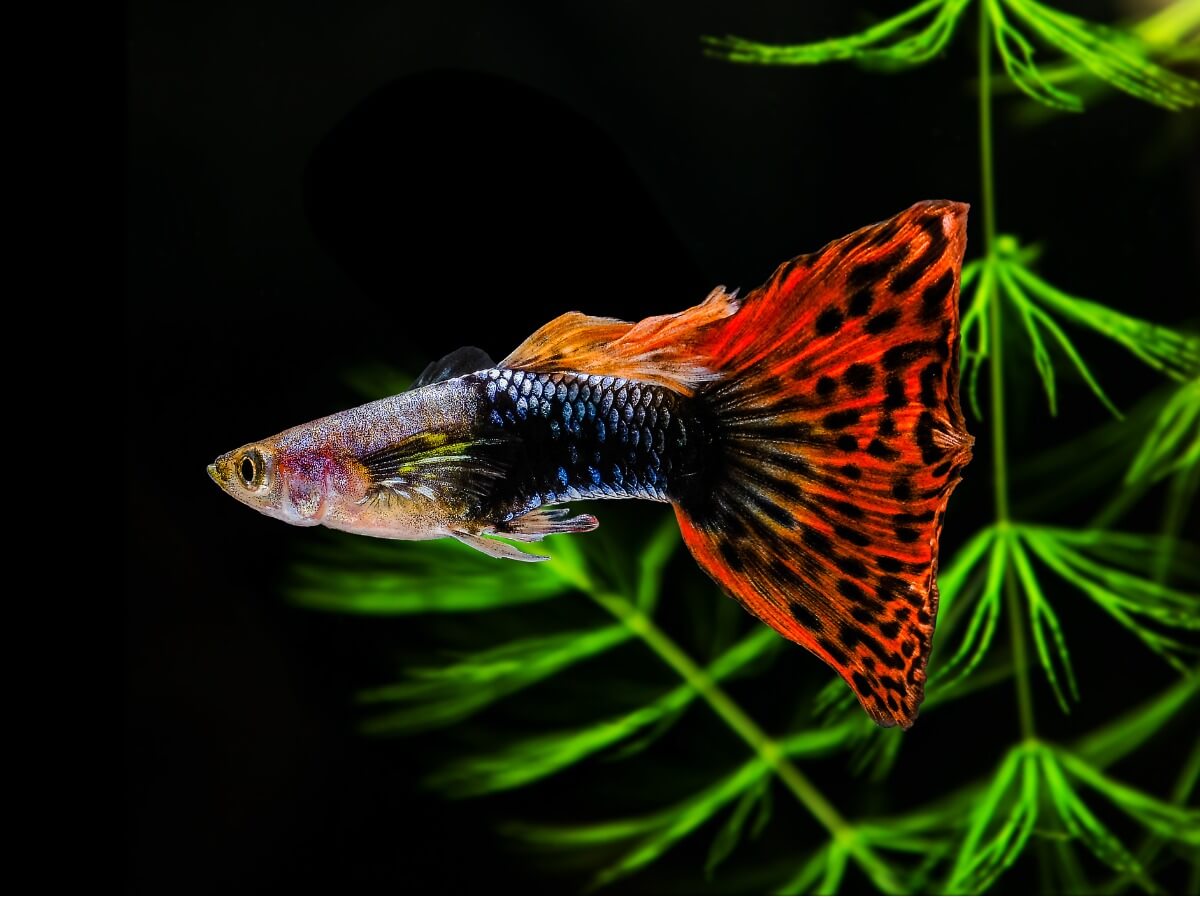
5. Zebrafish (Danio rerio)
A relative of the Rasbora galaxy, the zebrafish is another eye-catching option for a modest-sized tank. Keep in mind, however, that it’s a slightly larger species, ranging from 2 to 4 (or even 5) centimeters (from 1 to 2 inches). They’re also schooling fish, so we recommend that you keep at least 6 specimens together in the same tank.
- Minimum aquarium size: about 40 liters (8.8 gallons) for a school of 6 fish. If the volume is increased, it would be better, as more members will fit in.
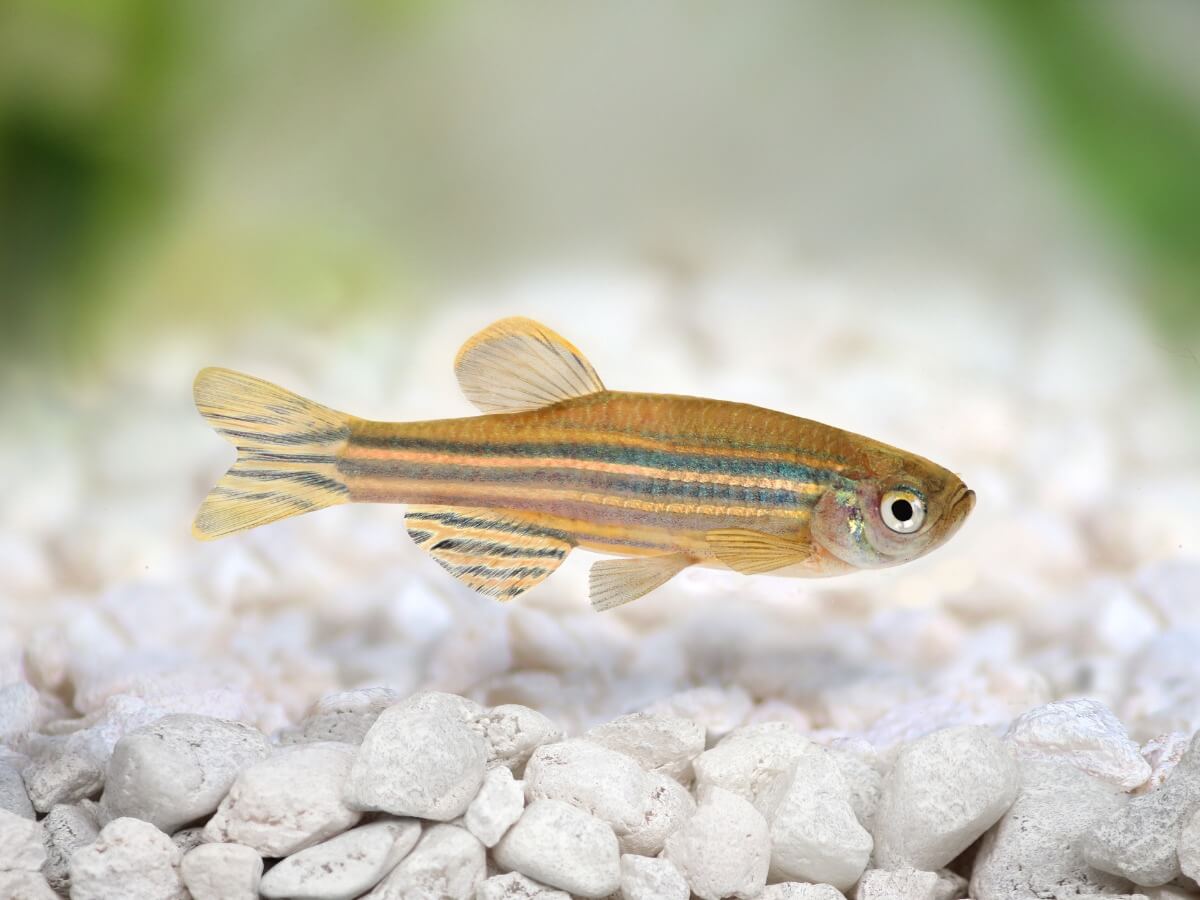
6. Endler’s livebearer (Poecilia wingei)
This fish belongs to the same genus as the guppy and can even hybridize with it. Its tail isn’t as striking as that of its relative, but the rest of its body is stunning with its black, phosphor blue and reddish tones. It’s an ideal fish for small aquariums, as it doesn’t usually exceed 4 centimeters (1.8 inches) in length and withstands water changes very well.
- Minimum aquarium size: some tutors have been able to keep a small group in 20-liter (4.4 gallons) tanks. However, the ideal is at least 40 liters (8.8 gallons) for a group of 5-6 fish.
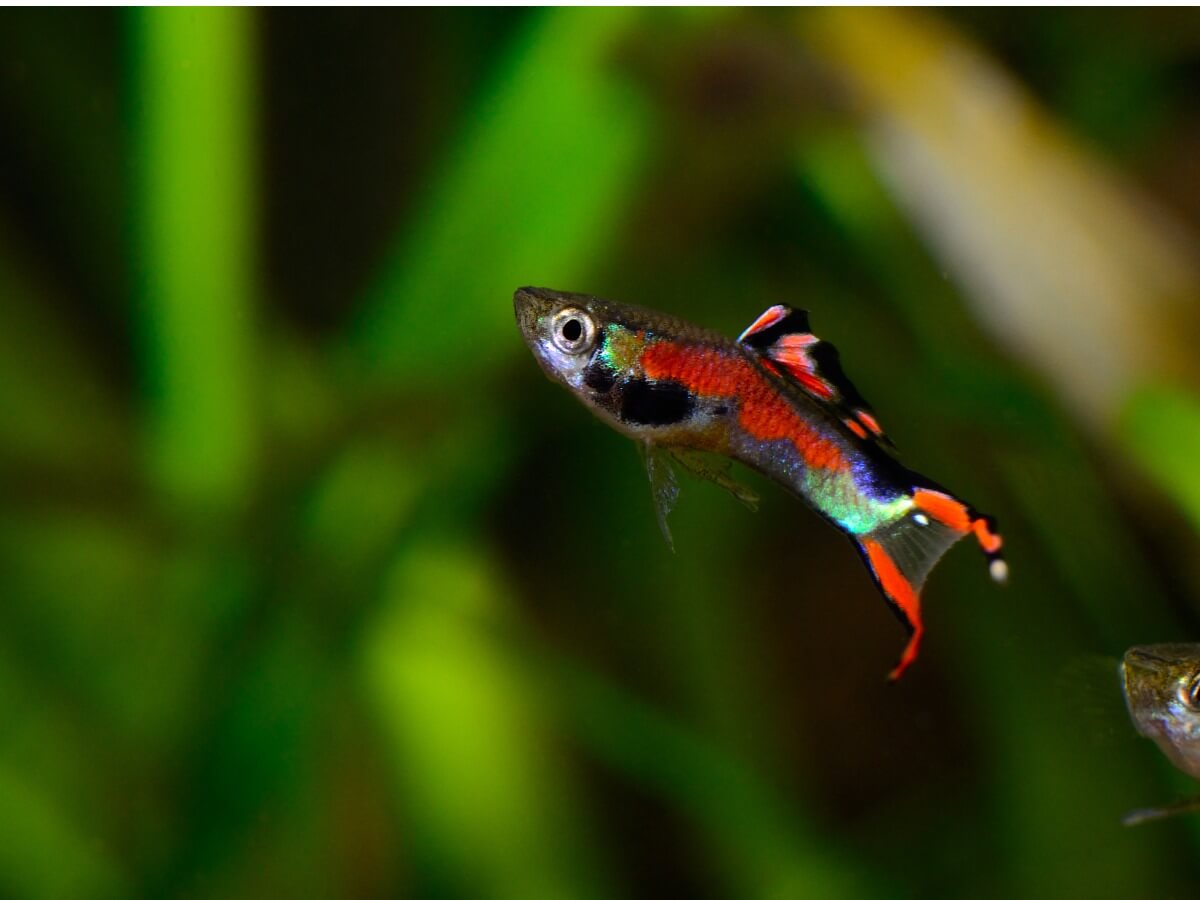
7. Chili rasboras (Boraras brigittae)
This is one of the smallest fish you’ll find for your tank. The specimens measure no more than 2 centimeters (0.8 inches) in their adult phase – incredibly small if we look back and compare it with the rest of the representatives of the list. Undoubtedly, this is the nano aquarium species par excellence.
Check out the beautiful video we’ve selected for you and get to know this lovely fish better!
- Minimum aquarium size: A group can be kept in an 18-liter (4-gallon) tank.
8. Tetra neon (Paracheirodon innesi)
Another ideal fish for a small aquarium because of its small size, no more than 3 centimeters (1.2 inches). In spite of its beautiful color and tiny size, it should be noted that it’s best to keep them in tanks of 80-100 liters (18 to 22 gallons). If you have only 4 or 5 fish together, a few dominant ones will become aggressive with the rest and live in constant stress. Each school should comprise at least 6 fish.
- Minimum aquarium size: 40 liters (8.8 gallons) for a group of 6 neons. If you want to avoid stress and fights, it is better to opt for an 80-liter (17.6 gallons) tank and keep a group of 10 to 12.
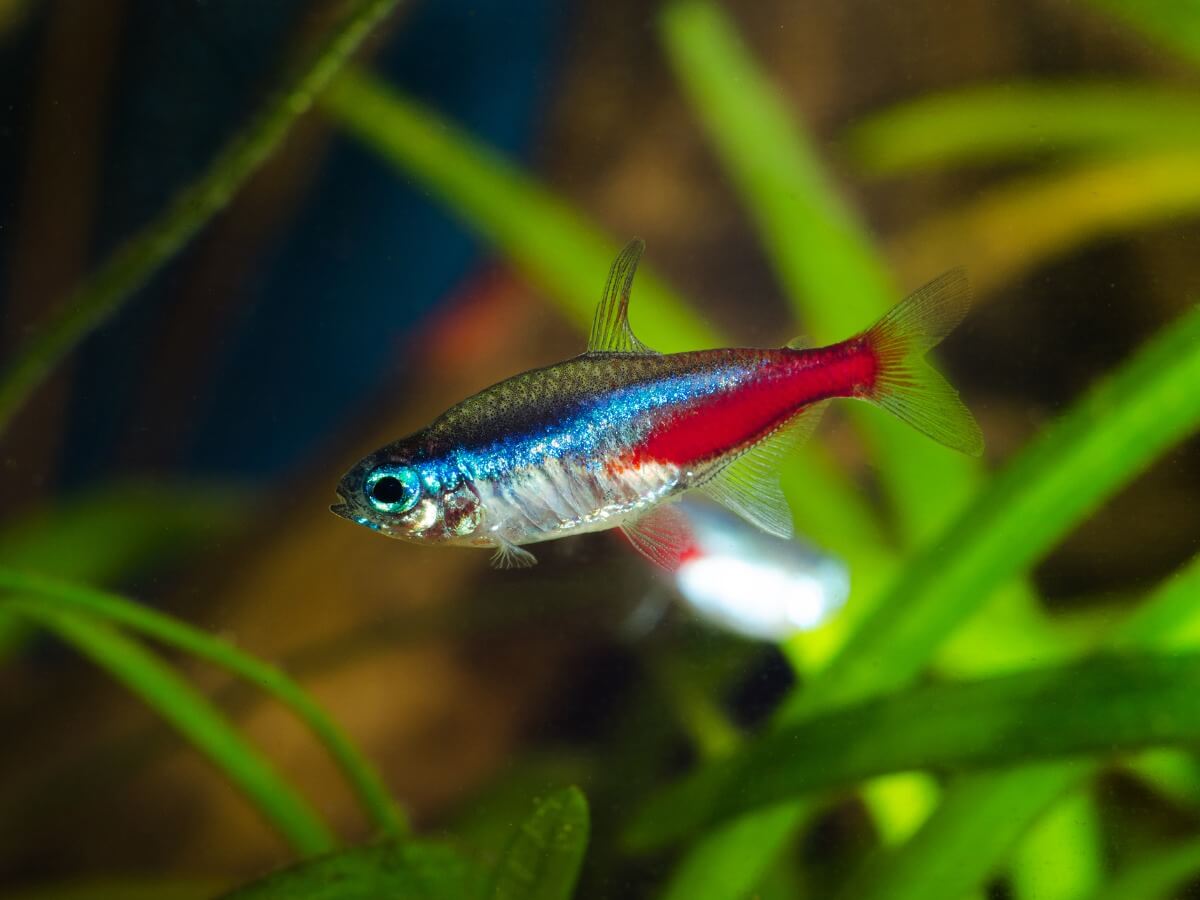
9. Red Notho (Nothobranchius rachovii)
We’re a bit outside of the norm at number 9, as Nothobranchius rachovii is a killi, quite different from the species already mentioned. The male has vivid reddish-blue colors and the female is gray. Both reach a maximum length of 6 centimeters (just over 2 inches). It’s a rather aggressive species and males tend to fight each other, so it’s best not to have more than one pair.
- Minimum aquarium size: 40 liters (8.8 gallons) for a couple.
Unfortunately, these fish don’t live very long, around a year or a year and a half.
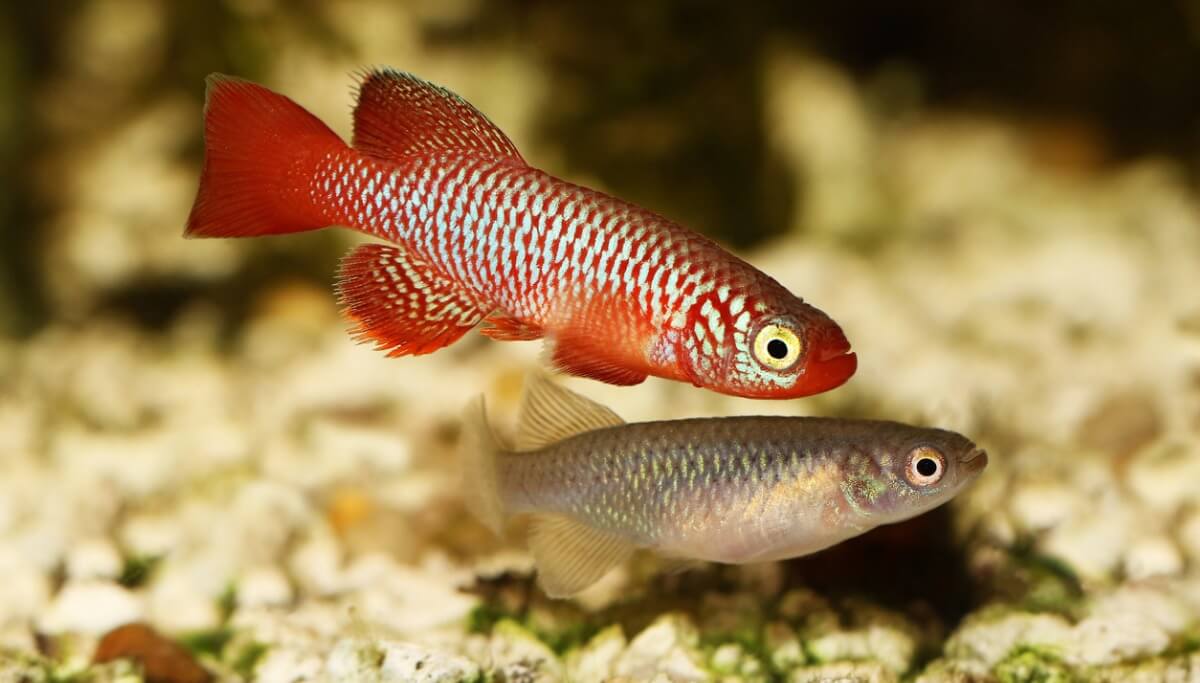
10. Pygmy gourami (Trichopsis pumila)
Few people know this species, as it hasn’t yet established itself among fish enthusiasts. However, it’s one of the most suitable fish for a small aquarium, especially since the adult specimens never exceed 4 centimeters (1.6 inches) in length. The pygmy gourami can be kept in groups and adapts very well to water changes.
- Minimum aquarium size: 18 liters (3.95 gallons) for a breeding trio.
What do you think of these 10 examples of fish for a small aquarium? Without a doubt, the pygmy gourami and the chili rasbora take the prize for being the smallest, but all the species mentioned here can be kept comfortably in a small tank of 40 liters (8.8 gallons) volume. What are you waiting for to set up yours?
Want to get started in the world of aquarium keeping but don’t know where to start? Maybe you’re looking for a large tank with a high volume, or on the contrary, you may have little space and want to start practicing with something more modest. If you’re considering the latter option, here are 10 fish for a small aquarium.
First of all, we need to define the term “small”. We’re going to work with volumes of 10 to 40 liters (2.2 to 8.8 gallons) as less would imply a lot of suffering for virtually any species on this list. In addition, you should keep in mind that in small tanks you need to measure the water parameters more often, as they fluctuate easily. So, without further ado, let’s get to it.
10 fish for a small aquarium
1. Betta fish (Betta splendens)
The betta is the king of freshwater fish. Originally from Southeast Asia, this fish is perfectly adapted to small aquariums. Moreover, because it has a special suprabranchial labyrinth organ, it’s able to take oxygen directly from the environment. Therefore, it doesn’t need the water to be well-oxygenated.
However, the fact that betta fish are hardy doesn’t mean that they can be kept in a glass of water or in a glass bowl. Under these conditions, it will suffer from fungal and bacterial infections and will eventually die. We recommend that, no matter how modest the tank, you get a heater and a basic filtering system for your specimen.
- Minimum aquarium size: 10 liters (2.2 gallons)

2. Galaxy rasbora (Danio margaritatus)
This fish, belonging to the same genus as the zebrafish (Danio rerio) was discovered in mid-2006 in Asia. It’s one of the most recently introduced species for aquarium enthusiasts, but has won people over with its reddish fins and yellowish spots all over its body.
This fish is very small (a maximum of 1.5 centimeters, just over half an inch), but requires more space than a betta as far as tank volume is concerned. As it’s a schooling species, at least 6 specimens must be acquired so that they don’t become depressed and die over time.
- Minimum aquarium size: 20-30 liters (4.4 to 6.6 gallons) minimum for 6 specimens.

3. Mosquitofish (Gambusia affinis)
The mosquitofish is quite similar to the guppy as far as body plan is concerned, but does not have such striking colors. They’re ideal fish for small aquariums, as females do not exceed 7 centimeters (nearly 2 inches) in length and males are no longer than 4 centimeters (less than 2 inches). Their small size and curious habits make them a very interesting option.
Unfortunately, this species is listed as one of the 100 most harmful invasive species in the world. It has been introduced in many ecosystems to kill mosquito larvae and has settled too well, displacing the native fauna in many regions. In addition, they’re gregarious animals, so it’s recommended that you increase the volume of the tank to hold more specimens.
- Minimum aquarium size: about 20 liters (4.4 gallons) for a trio would be fine. However, a 60-liter tank (13.2 gallons) is recommended to hold about 25 specimens together.

4. Guppy fish (Poecilia reticulata)
What can we say about this fascinating species? Guppies are ideal fish for a small aquarium, as males range in length from about 2 centimeters (just under an inch) and females almost never exceed 5 centimeters (2 inches). They’re even smaller than Gambusia, and they also show fascinating colors on their tails. Undoubtedly, one of the best options for people new to this hobby.
- Minimum aquarium size: 40 liters (8.8 gallons) for a breeding group. They’re very prolific, so consider moving them to a larger tank at a later date.

5. Zebrafish (Danio rerio)
A relative of the Rasbora galaxy, the zebrafish is another eye-catching option for a modest-sized tank. Keep in mind, however, that it’s a slightly larger species, ranging from 2 to 4 (or even 5) centimeters (from 1 to 2 inches). They’re also schooling fish, so we recommend that you keep at least 6 specimens together in the same tank.
- Minimum aquarium size: about 40 liters (8.8 gallons) for a school of 6 fish. If the volume is increased, it would be better, as more members will fit in.

6. Endler’s livebearer (Poecilia wingei)
This fish belongs to the same genus as the guppy and can even hybridize with it. Its tail isn’t as striking as that of its relative, but the rest of its body is stunning with its black, phosphor blue and reddish tones. It’s an ideal fish for small aquariums, as it doesn’t usually exceed 4 centimeters (1.8 inches) in length and withstands water changes very well.
- Minimum aquarium size: some tutors have been able to keep a small group in 20-liter (4.4 gallons) tanks. However, the ideal is at least 40 liters (8.8 gallons) for a group of 5-6 fish.

7. Chili rasboras (Boraras brigittae)
This is one of the smallest fish you’ll find for your tank. The specimens measure no more than 2 centimeters (0.8 inches) in their adult phase – incredibly small if we look back and compare it with the rest of the representatives of the list. Undoubtedly, this is the nano aquarium species par excellence.
Check out the beautiful video we’ve selected for you and get to know this lovely fish better!
- Minimum aquarium size: A group can be kept in an 18-liter (4-gallon) tank.
8. Tetra neon (Paracheirodon innesi)
Another ideal fish for a small aquarium because of its small size, no more than 3 centimeters (1.2 inches). In spite of its beautiful color and tiny size, it should be noted that it’s best to keep them in tanks of 80-100 liters (18 to 22 gallons). If you have only 4 or 5 fish together, a few dominant ones will become aggressive with the rest and live in constant stress. Each school should comprise at least 6 fish.
- Minimum aquarium size: 40 liters (8.8 gallons) for a group of 6 neons. If you want to avoid stress and fights, it is better to opt for an 80-liter (17.6 gallons) tank and keep a group of 10 to 12.

9. Red Notho (Nothobranchius rachovii)
We’re a bit outside of the norm at number 9, as Nothobranchius rachovii is a killi, quite different from the species already mentioned. The male has vivid reddish-blue colors and the female is gray. Both reach a maximum length of 6 centimeters (just over 2 inches). It’s a rather aggressive species and males tend to fight each other, so it’s best not to have more than one pair.
- Minimum aquarium size: 40 liters (8.8 gallons) for a couple.
Unfortunately, these fish don’t live very long, around a year or a year and a half.

10. Pygmy gourami (Trichopsis pumila)
Few people know this species, as it hasn’t yet established itself among fish enthusiasts. However, it’s one of the most suitable fish for a small aquarium, especially since the adult specimens never exceed 4 centimeters (1.6 inches) in length. The pygmy gourami can be kept in groups and adapts very well to water changes.
- Minimum aquarium size: 18 liters (3.95 gallons) for a breeding trio.
What do you think of these 10 examples of fish for a small aquarium? Without a doubt, the pygmy gourami and the chili rasbora take the prize for being the smallest, but all the species mentioned here can be kept comfortably in a small tank of 40 liters (8.8 gallons) volume. What are you waiting for to set up yours?
All cited sources were thoroughly reviewed by our team to ensure their quality, reliability, currency, and validity. The bibliography of this article was considered reliable and of academic or scientific accuracy.
- Courtenay Jr, W. R., & Stauffer Jr, J. R. (1990). The introduced fish problem and the aquarium fish industry. Journal of the world Aquaculture Society, 21(3), 145-159.
- Lecchini, D., Polti, S., Nakamura, Y., Mosconi, P., Tsuchiya, M., Remoissenet, G., & Planes, S. (2006). New perspectives on aquarium fish trade. Fisheries Science, 72(1), 40-47.
- Roberts, H., & Palmeiro, B. S. (2008). Toxicology of aquarium fish. Veterinary clinics of North America: exotic animal practice, 11(2), 359-374.
This text is provided for informational purposes only and does not replace consultation with a professional. If in doubt, consult your specialist.








